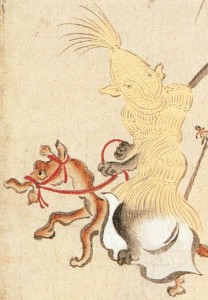I Find This Difficult To Believe
I could have sworn — sworn! — that I talked about my love of yokai — traditional Japanese monsters — more than just twice in passing in all the years I’ve been writing this here blog. I mentioned Gegege no Kitaro in passing way the hell back in 2007, and I talked about Jim Zub’s treatment of kappa (which I first learned about by watching Gegege no Kitaro) back in July. I guess I had a conversation with Maki Naro in 2013 (probably at NYCC that year) when Drawn & Quarterly’s collection of late-60s Kitaro¹ came out, and that’s it.
Guys, I love yokai. From the barely-contextualized references in old Japanese TV shows to the present day, the endless parade of spooks, haunts, fantastic creatures, and things that go bump in the night have always grabbed me. Sometimes they’re just there and it’s up to you to figure out which are traditional and which have just been made up for the hell of it, as in Miyazaki’s unparalleled Sen to Chihiro no Kamikakushi. Sometimes you get ’em in story and the endnotes give you the background, as Stan Sakai has been doing for 30 years or so in the pages of Usagi Yojimbo, or Zub’s been doing recently in Wayward. From mildly spooky to simply odd, bit players and tourist attractions to vicious and deadly, yokai come in every shape, size, temperament, and purpose imaginable.
And yet, above all, they have a fundamental weirdness to them. Very polite turtle-men that will drown you to eat the inside of your rectum, but who can be bought off with a cucumber? Sure! Haughty bird-men that had a special dislike of priests, but also protect forests and teach the arts of war? Why not! Foxes with nine tails and shifting forms², household items come to life because they’re existed for too long? Hungry ghosts licking the filth from dirty bathrooms? Disembodied body parts flying about causing panic? Check, check, and check.
And when I think about comics, and fundamental weirdness, the first name that comes to mind is that of KC Green, and what do you know? Dude’s gone and drawed himself some yokai, and started up a weekly project around it. The first two are the karakasa-kozō (an umbrella come to life because why not) and the umi-bōzu (the sea monk, a personification of every sailor’s nightmares), with the promise of more yokai to come on a weekly basis, or as the mood strikes him. Check out his Tumblr under the tag yokai and embrace the Night Parade.
Oh, and maybe check the milk in the fridge. It’s getting a little old, and if it sprouts an eye, you’ll want to take care of that.
Spam of the day:
It’s impressive that you are getting ideas from this piece of writing as well as from our argument made here.
Far be it from me to complain about not getting spam (the new filters are doing a great job), but it’s really gotten kind of … generic. Where’s the batshit insanity about defamation laws and Kraft dinner and Ukrainian women that want to meet me?
________________
¹ Shigeru Mizuki, Kitaro’s creator, is widely credited with both exhaustively cataloging yokai and reviving interest in what had been an all-but-forgotten bit of folklore. He’s also created dozens of new yokai to reflect the realities of the modern world.
² Although it appears that pretty much every culture around the world has decided that foxes are sneaky and not trustworthy.

The above comments are owned by whoever posted them. The staff of Fleen are not responsible for them in any way.